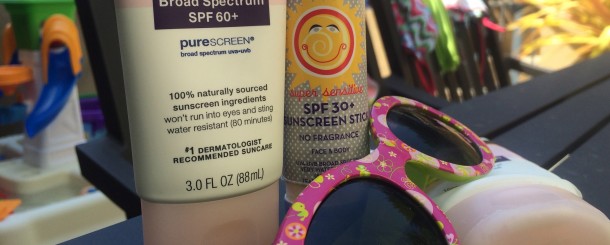I admit it – I’m a bit lax about putting sunscreen on my 22-month-old daughter.
If we’re going to be spending a while at the playground, I make sure to put it on her, but if we’re just out and about running errands, I often skip applying the screen.
However, lately, I’ve been wondering whether there is a hard-and-fast rule regarding the application of sunscreen on little ones. Are we supposed to be applying it every time our bundles of joy go outside, or is a more laid-back approach like mine okay?
So, just in time for summer, I turned to the always-helpful Nurse Judy, the advice nurse at my daughter’s pediatrician’s office, to get her take. Her sunscreen rule of thumb makes up today’s hint.
And here it is: Apply sunscreen 15 minutes prior to exposure if your little one is going to be outside for more than 30 minutes between the hours of 10 a.m. and 4 p.m., and reapply the lotion every two hours.
Beyond that, a little sun exposure without screen here and there should be fine (and remember that the outside temperature doesn’t have much to do with the need for sunscreen).
“I’m not going to worry about the little 10 minutes here and there that someone is outside,” she says, noting that a floppy hat (I like this one by Sunday Afternoons) and shade can do the job just fine during those times. In fact, a little sun exposure here or there “is not the end of the world – it feels great and gives a dose of vitamin D,” Judy wrote last year in a post on the subject on her blog.
There are exceptions to this rule, however, she points out. If your child has very fair skin, you’ll want to apply screen before any sun exposure. Plus, Judy says, it’s a good idea to have the sunscreen along with you always, so you’re covered if you’re out longer than you expected during midday when the sun is strongest.
Of course, there certainly are medical experts who would suggest that you apply sunscreen to any kid — and to yourself – before any sun exposure.
Still, the all-the-time application approach probably isn’t realistic for many parents (at least, it isn’t for me and my forgetful mommy brain). Plus, it can be very expensive if you’re applying the fancy and pricey baby sunscreens many doctors recommend, such as California Baby brand sunscreens.
This is why, at least for now, I’m sticking with Judy’s rule of thumb, I’m following a number of the helpful sunscreen tips recently covered over at Mamahacks and I’m also opting for safe and reasonably priced sunscreens available at the drugstore (like the Neutrogena baby sunscreen I’m using now or these lotions highlighted over at PopSugar Moms).
Do you agree with the rule of thumb mentioned above – why or why not? What are your tips and questions related to applying sunscreen on kids? Share your thoughts below.
Follow Hint Mama on Facebook and Twitter, and read more about her and her disclosures.







Great post on sunscreen! I always wonder if I’m putting on too much or not enough. (I know for adults it’s a shot glass worth.) I like the flap happy baby hat.
Thanks! Your shot-glass tip sounds like a great sunscreen rule of thumb for adults:)
I have a redheaded daughter with very fair skin, so we are vigilant for pool and park trips. But I don’t worry with it for a few minutes in the sun here and there. Vitamin D is important and who has the time to apply sunscreen that often?
All depends on your child and where you are located. Here in the hot Florida sun, we apply every single morning. Incidence of melanoma on the left arm (sun exposure through car window when driving- would you believe?) is much higher here … I’m not chancing it. I absolutely love sun protective clothing like coolibar when I am too rushed to apply on very little spot (I am indeed a publicist but do not rep coolibar or any other sun protective gear… Just my opinion). Good post and great to keep this conversation going.
My understanding was that mineral-based (such as zinc oxide) sunscreens do not carry the same 30 minute waiting period after application as the more common chemically-acting ones. Are there sources that say otherwise?